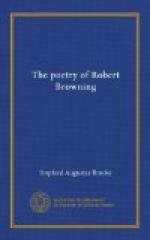The poem closes with a charming lyric, half-sad, half-joyful, in which he hails the spring, and which in itself is full of his heart when it was close to the hopefulness he drew from natural beauty. I quote it to close this chapter:
Dance, yellows and whites
and reds,
Lead your gay orgy, leaves,
stalks, heads
Astir with the wind in the
tulip-beds.
There’s sunshine; scarcely
a wind at all
Disturbs starved grass and
daisies small
On a certain mound by a churchyard
wall.
Daisies and grass be my heart’s
bed-fellows,
On the mound wind spares and
sunshine mellows:
Dance you, reds and whites
and yellows.
FOOTNOTES:
[4] David could only have seen this on the upper slopes of Hermon. But at the time of the poem, when he is the shepherd-youth, he could scarcely have visited the north of Palestine. Indeed, he does not seem all his life long to have been near Hermon. Browning has transferred to David what he himself had seen in Switzerland.
* * * * *
CHAPTER III
THE TREATMENT OF NATURE
In the previous chapter, some of the statements made on Browning as a poet of Nature were not sufficiently illustrated; and there are other elements in his natural description which demand attention. The best way to repair these deficiencies will be to take chronologically the natural descriptions in his poems and to comment upon them, leaving out those on which we have already touched. New points of interest will thus arise; and, moreover, taking his natural description as it occurs from volume to volume, we may be able—within this phase of his poetic nature—to place his poetic development in a clearer light.




